If you’ve decided to become more sustainable at home, your kitchen is probably one of the main areas of your life that you’ve focused your attention to.
Between food packaging, plastic cooking utensils, paper towels and napkins, and chemical-filled cleaners, the kitchen has a lot of potential to be an environmentally impactful place in your life.
Here are 30 zero waste kitchen ideas to help you build a no-waste kitchen, from shopping and cooking to dining and cleaning.
This article may contain compensated/affiliate links. See our full disclosure here.
Table of Contents
Zero Waste Kitchen Swaps
Working towards a zero waste kitchen is more than just swapping out plastic bags for reusable, or quitting your bottled water habit. There are so many more ways in which we can reduce waste – both inorganic and organic – with just a few adjustments to our daily routines.
Here are 30 simple Zero waste swaps for your kitchen.
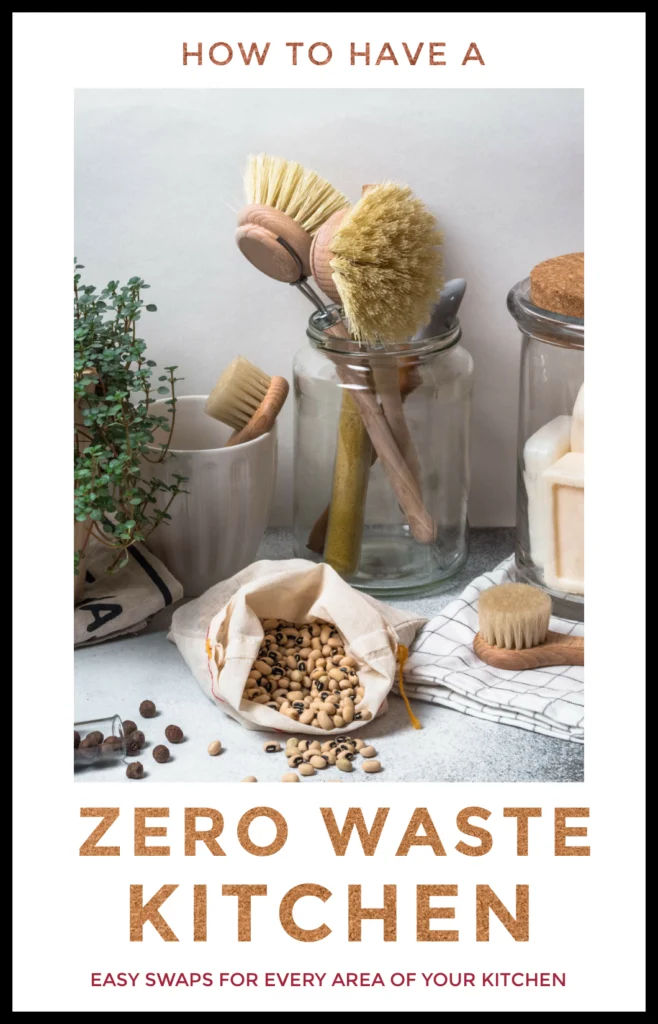
ZERO WASTE PANTRY AND FRIDGE
Start your zero waste kitchen journey the simplest way possible – in the pantry and fridge. Here’s how!
Buy in bulk from your local co-op
Buying your dry goods in bulk is one of the main things you can do to achieve a plastic-free kitchen. Your local co-op probably has dry goods like nuts, seeds, beans, rice, flour, spices, coffee beans, tea leaves, popcorn and other foods that you can buy and put in your own reusable containers.
Bulk goods are generally cheaper too, so you can save money and the planet all while indulging in delicious zero-waste cooking.
Buy loose fruits and vegetables from your local farmers market
Buying fruits and vegetables free of plastic isn’t the only sustainability concern that comes with produce – buying in season and from your local farmers can do wonders in terms of sustainability.
Produce bought at your local farmer’s market can also end up being cheaper, tastier, and healthier than produce bought at a traditional grocery store.
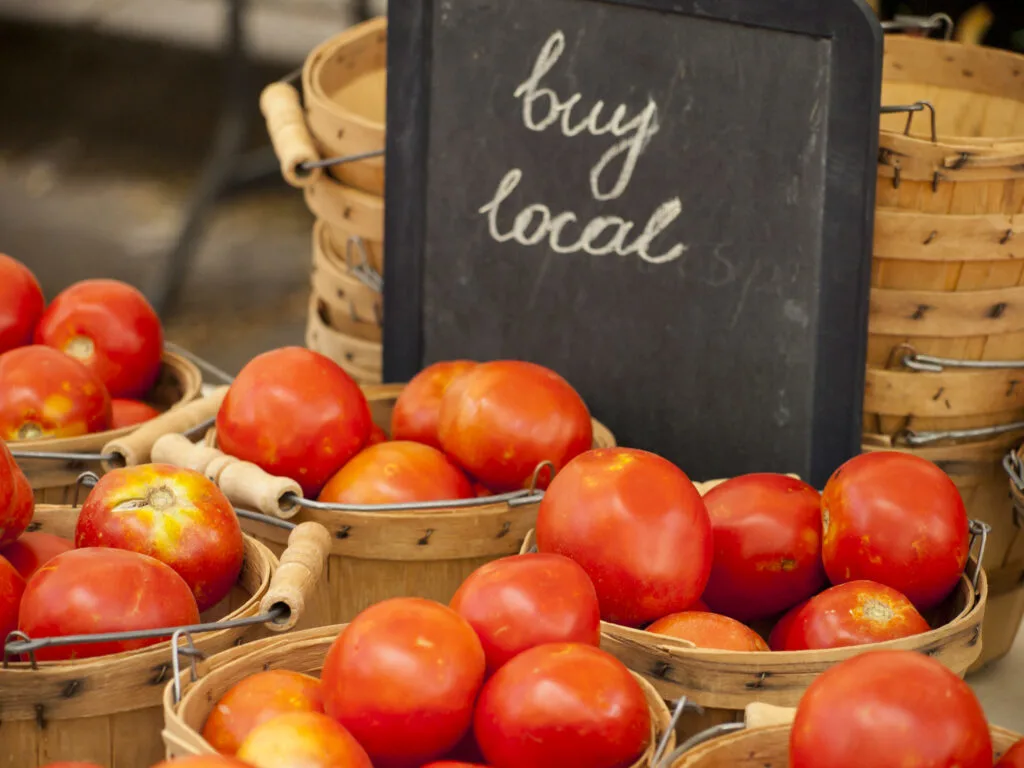
Opt for paper, aluminum, and glass packaged foods over plastic
For the foods you can’t buy in bulk, opt for ones packaged in materials like paper, metal, and glass. Paper can be composted, and aluminum and glass can be infinitely recycled, unlike plastic. If you do buy a lot of aluminum canned foods, try to find BPA-free cans.
Opt for vegan and vegetarian staples
When it comes to sustainability, it’s not just how you buy, but what you buy. Animal agriculture is one of the leading drivers to climate change, so to help the planet, opt for vegan, or at the very least vegetarian, foods.
If for some reason you need to buy meat, try to source it from a local farmer that grass-feeds their animals and has transparent farming practices.
ZERO WASTE COOKING
As with shopping, what you use to cook your food can leave an impact too.
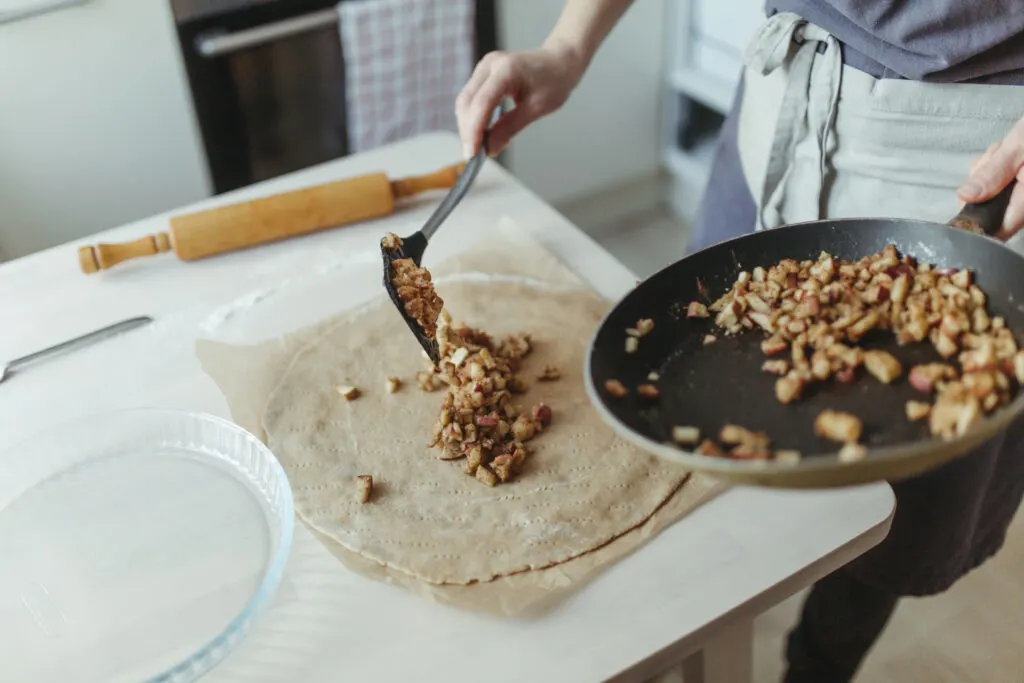
Invest in long-lasting pots and pans
A lot of cookware is made cheaply with potentially toxic non-stick coatings that will start chipping off after repeated use. To avoid this, opt for investing in long-lasting pots and pans made with stainless steel or my personal favourite, cast iron.
Zero waste coffee and tea
To avoid creating waste with your daily beverage, invest in brewing options that are reusable and sustainable. For tea, buy a stainless steel tea ball brewer instead of using traditional tea bags (which often contain plastic particles). And for zero waste coffee, opt for a french press or reusable k-cups.
Whether you’re a tea or coffee drinker, you’ll want to buy the beans/leaves in bulk at your local co-op, or online from a plastic-free source. And don’t forget your reusable coffee mug for on-the-go drinking!
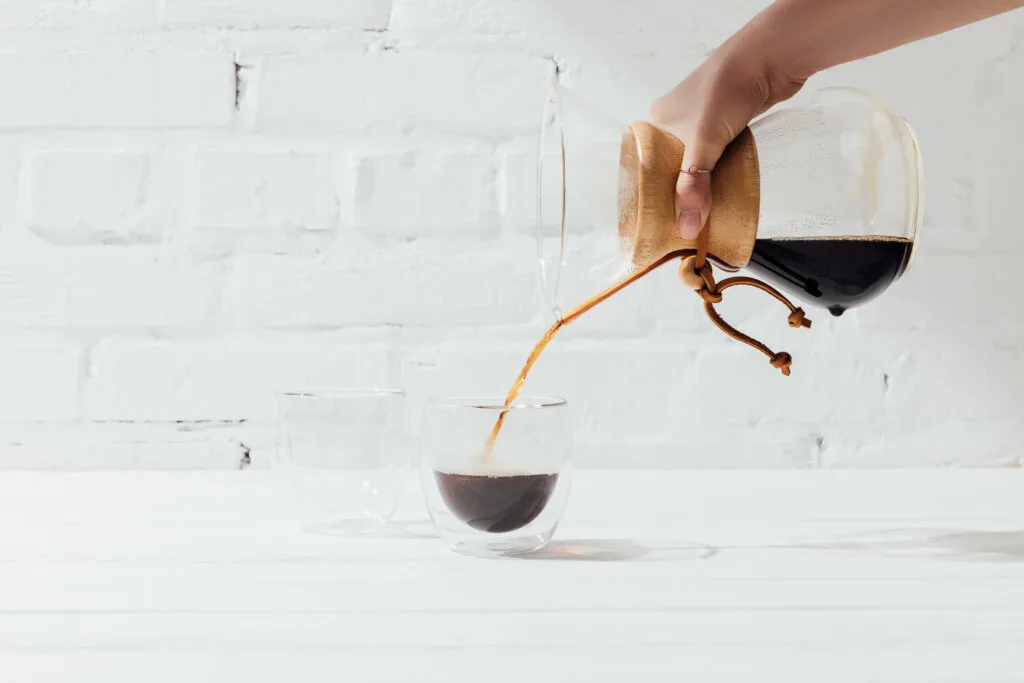
Use glass casserole dishes and aluminum baking sheets (and make them last)
For baking, using glass casserole dishes and aluminum baking sheets is pretty standard across the board. But, what’s important is that you make these products last, and that you don’t throw them out just because they have visible signs of wear and tear.
If you’re in the market for a casserole dish, Pyrex glass dishes can’t be beaten on quality and they’ll last you a lifetime. As for baking sheets, these simple aluminum baking sheets will go the distance!
Use a reusable, silicone baking mat
If you want to stop using so much oil or single-use parchment paper when baking, invest in a reusable silicone baking mat. These can replace hundreds of pieces of parchment paper and will keep your food from sticking to the pan.
Not having to buy so much parchment paper will not only help save on environmental resources but will save you money in the long run – it’s a win-win.
Opt for wooden cooking utensils
For stirring, mixing, or flipping, opt for cooking utensils made with 100% wood or bamboo. These not only last longer than utensils made with plastic, but they are a more sustainable choice, too.
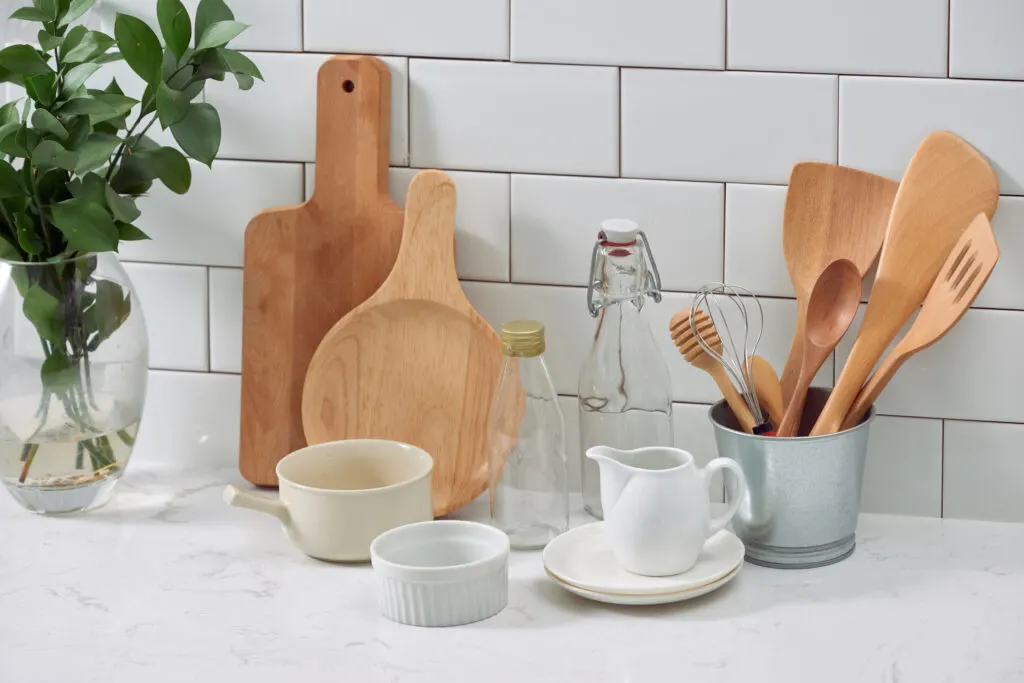
Try to buy refurbished or used appliances
Whether you’re buying a fridge, an oven, or a dishwasher, chances are you can find a refurbished or secondhand one that’s like-new, more cost-effective, and easier on the environment.
Buying secondhand appliances is especially important considering the toxic e-waste components that arise when these appliances are thrown out.
However, you don’t want to buy an old appliance if it’s going to cost more every and water use in the long-run. So the next best thing is buying an energy star certified appliance. PS – you can filter these out easily on Amazon.
Avoid single-purpose products
If you ever watch cable TV, you’ve probably seen countless commercials for small appliances, like avocado pitters, that are built for just one small purpose – pulling the pit out of your avocado.
These products are usually just a waste of resources and money, considering they usually accomplish tasks that can easily be completed with utensils you already have around the house.
This applies for other appliances as well – don’t buy a fancy mixer if you’ll only use it once or twice a year, and can accomplish the same with a mixing bowl, a whisk, and a little arm power.
ZERO WASTE DINNERWARE
When in search of new dinnerware, try to think about investing in quality pieces that you’ll be proud to use for years to come. Rather than buying cheap and changing often.
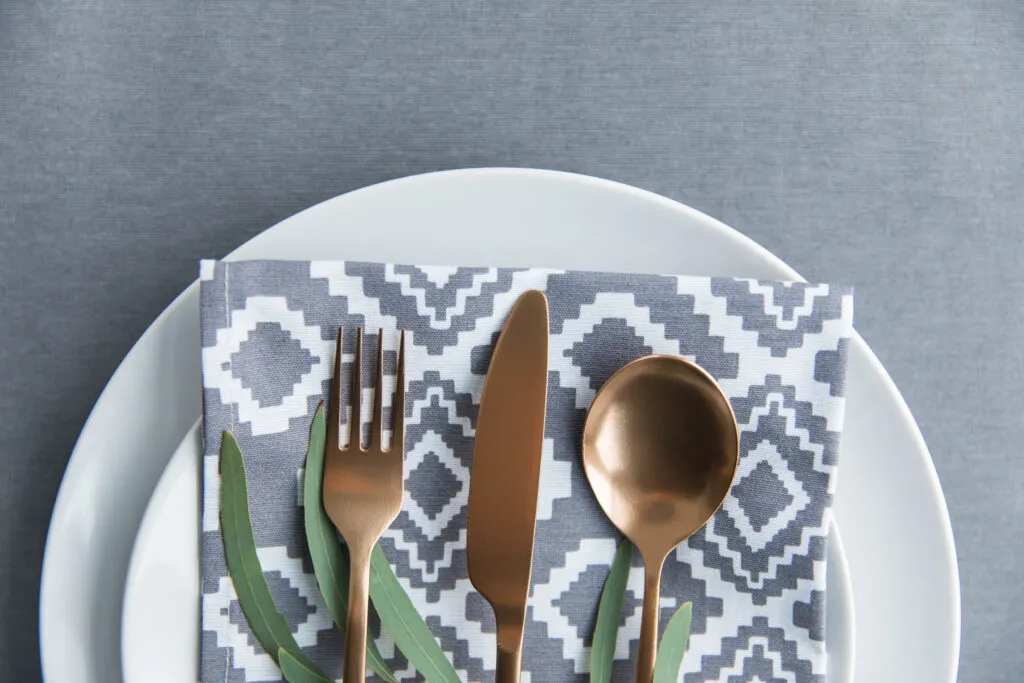
Buy second hand, from a local artisan, or from a BIPOC-owned business
If you’re going Zero Waste on a budget, you can always scour your local thrift stores for new-to-you plates, bowls, or silverware.
However, if you’re looking for something a bit special, buy it from a local artisan or local BIPOC-owned business. Chances are there’s a business or potter in your area that makes plates, bowls, mugs, silverware, or any other dinnerware that you need.
Use cloth napkins
Ditch the single-use paper napkins and paper towels for cloth napkins. Not only do they provide a better user experience and can spruce up your table setting, but they can help cut down on paper resources, considering paper napkins and towels contribute to deforestation, which drives climate change, wildfires, and other environmental impacts.
ZERO WASTE FOOD STORAGE
Cutting down on food waste is important, but how do you store those leftovers without plastic?
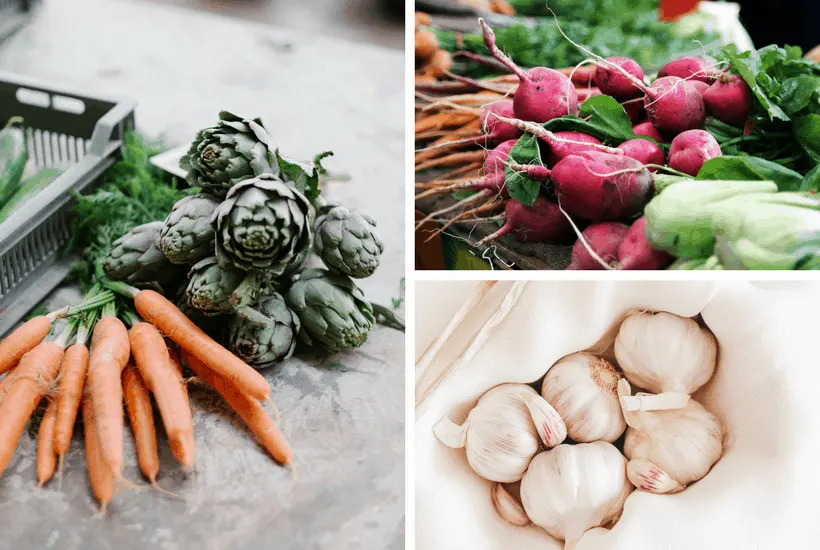
Use glass containers
To store your bulk goods or leftovers, glass is always a good bet. Chances are, you buy foods packaged in glass jars that you can upcycle to store your food, or you can find mason jars or other containers at the thrift store or online. They’ll then serve you for years without needing replacing. You can even use glass jars for zero waste breast milk storage!
The freezer is your friend
If you have vegetables, legumes, fruits, or other foods that are on the brink of going bad, freeze them in a glass container or reusable silicone bag for later. This will help you avert food waste, and will save you money in the long run.
Related reading: How to Store Produce Without Plastic
Always eat your leftovers
Most people that have leftovers will ultimately never eat them, either because they forget about them or are bored of them, leading to unnecessary food waste. When you put leftovers in your fridge, put them towards the front so you don’t forget about them.
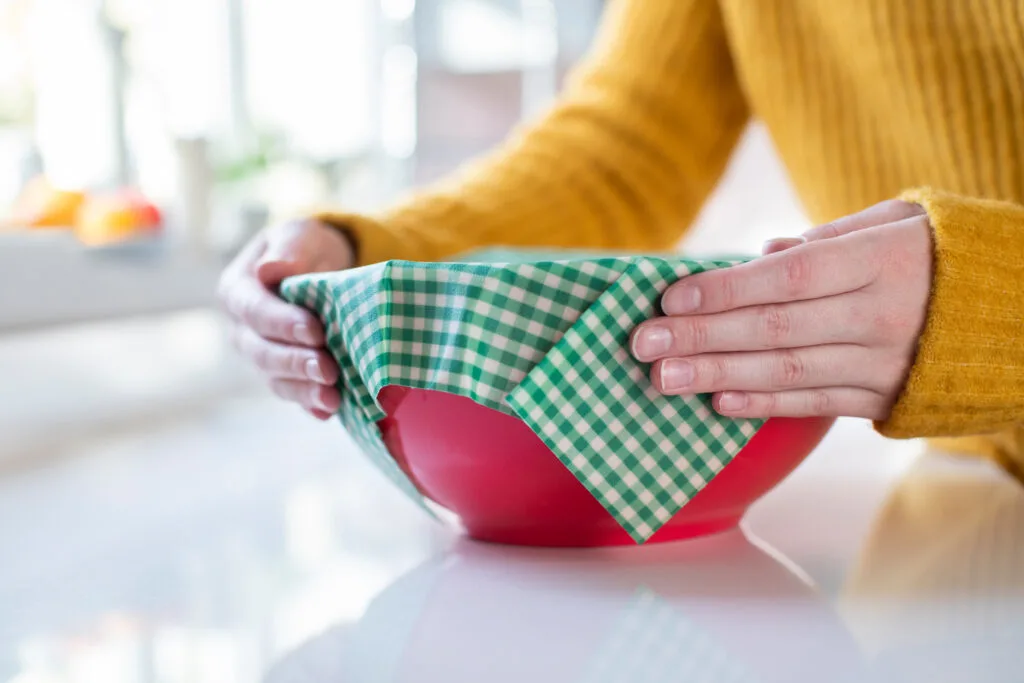
Ditch the plastic wrap and bags
Needless to say, plastic wrap and bags are bad for the environment. To replace plastic wrap, get beeswax wrap or this vegan alternative. You can buy large sizes to cover bowls or smaller sizes to cover smaller containers.
To replace plastic bags, you can buy reusable bags made of organic cotton to pack your snacks, reusable bags made of silicone to freeze fruit or veg, or you can just use thrifted Tupperware for all of the above. These are some of those zero waste kitchen essentials that you can’t pass up.
COMPOSTING AND RECYCLING
It’s not just the inorganic matter we have to worry about in our kitchens, it’s the food waste too. Here are some ideas on how to avoid throwing out food.
Upcycle your food waste
Instead of composting your food waste, see if you can upcycle it first. Vegetable scraps can be turned into veggie stock, and coffee grounds can be used in scrubs or on your garden. Get creative as there are endless possibilities!
Compost all organic waste
For any food waste you can’t upcycle, compost it. You can either create your own composting system at home, get it picked up by a composting service, or drop it off at a local community garden.
In between getting your compost picked up or dropping it off, you can store it in your freezer to avoid any flies or smells, or get a compost specific can (this is the one I have) that absorbs smells and keeps pests out.
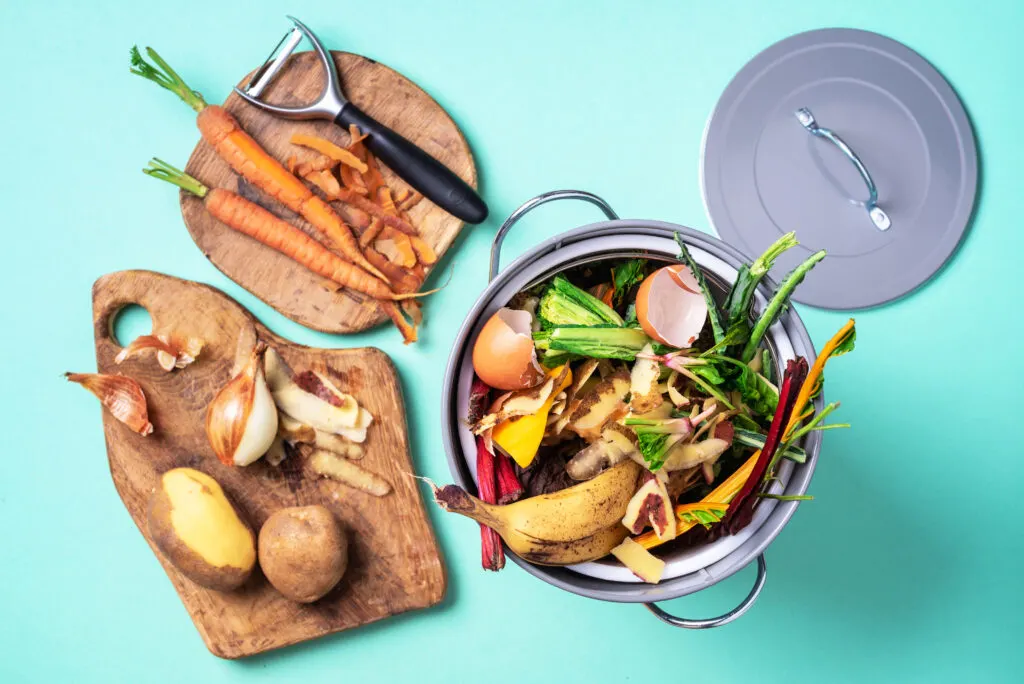
Recycle plastic, paper, glass, and aluminum
For any plastic, paper, glass, or aluminum packaging, recycle it. These materials are pretty universally recycled, but you’ll want to check with your local waste management service to make sure they don’t have any exceptions.
ZERO WASTE CLEANING
Having a zero waste kitchen doesn’t begin and end with the food. It’s also about how you care for and clean your space.
Surfaces
To clean your kitchen surfaces, find a DIY cleaning spray that works for your purposes, or buy bulk cleaning spray from your local co-op or online (like this one).
Wipe down counters, appliances, and other surfaces with this spray and a reusable rag. Rags can be made from old towels or cotton clothes you have laying around, or clothes you find at a thrift store.
Just a note – if you have granite countertops, avoid any cleaning solution made with vinegar.
Floors
To clean floors, sweep with a broom made with 100% natural materials, and then find a zero waste mop that works for you and your zero waste kitchen cleaning routine.
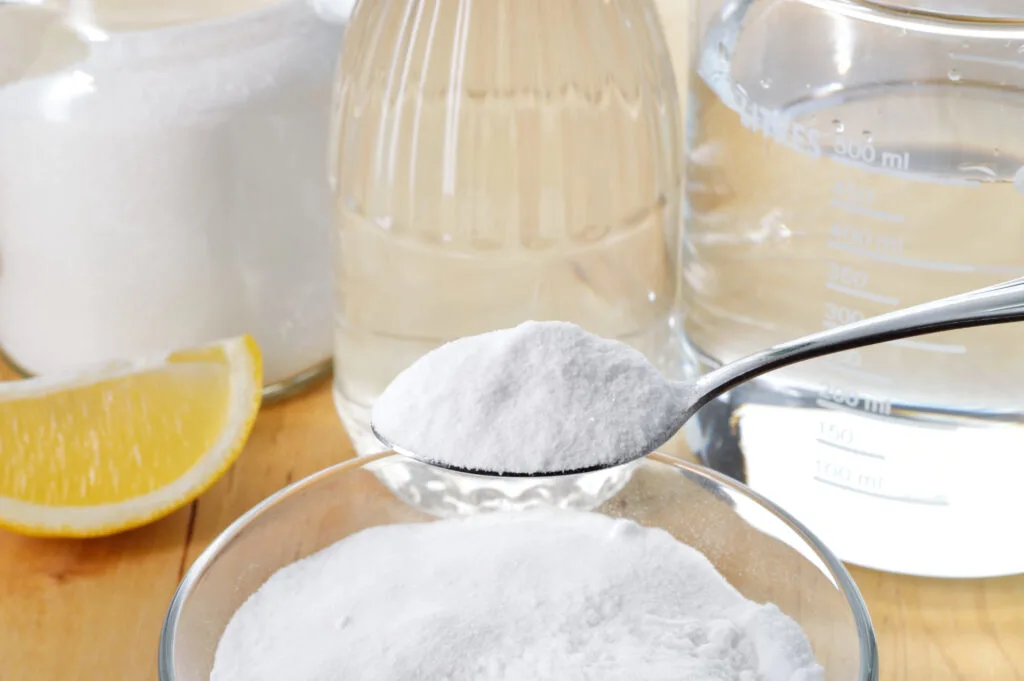
Freshen up your garbage disposal
To clean and freshen up your garbage disposal, pour baking soda into the disposal and then cover it with vinegar. Let it sit for a few minutes before rinsing the mixture out with running water.
To lighten up the smell, take small slices of a lemon rind and grind them in the disposal.
Steam your microwave
You can clean the inside of your microwave like you would any other surface, but to loosen stuck on food and make your job a little bit easier, microwave a cup of water for a couple of minutes.
The steam will soften the food that’s stuck in the appliance, making it easier to wipe down.
Oven and stove
To clean your oven, spray it down with vinegar and then sprinkle with baking soda. Let it sit overnight before scraping it and wiping it down with your all purpose cleaning spray.
To clean your stovetop, you can use your regular all purpose spray with baking soda for extra scrubbing power.
ZERO WASTE DISHWASHING
Wondering how you can make your dish washing routine more environmentally friendly? Check out these easy zero waste swaps.
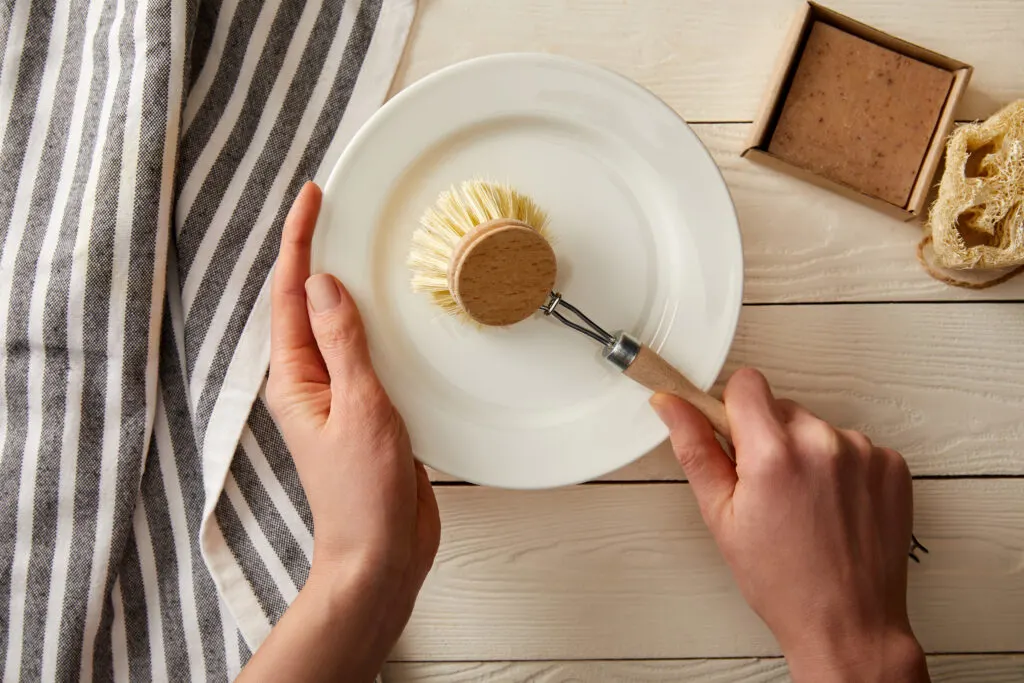
Check your dishwasher’s efficiency
The efficiency of your dishwasher will really determine whether or not hand washing or machine washing is the most sustainable option for your dishes.
If you have an older model, hand washing may be more efficient. This article breaks down the complexities of the age-old debate.
Use soap bars or refillable dish soap
Whether you’re washing dishes by hand or in the machine, you’re going to need a zero waste soap option. If you’re washing by hand, you can use either a solid bar of dishwashing soap or bulk dish soap from your local co-op.
If you’re washing in a machine, you can make DIY dishwashing liquid or buy zero waste dishwashing pods.
Opt for wooden dish brushes
If you’re washing by hand, opt for a wooden dish brush with compostable bristles. You could also use a zero waste sponge made with cotton or other plant-based, compostable materials like walnuts. These plastic free kitchen products can save you a lot of money and unnecessary waste in the long run.
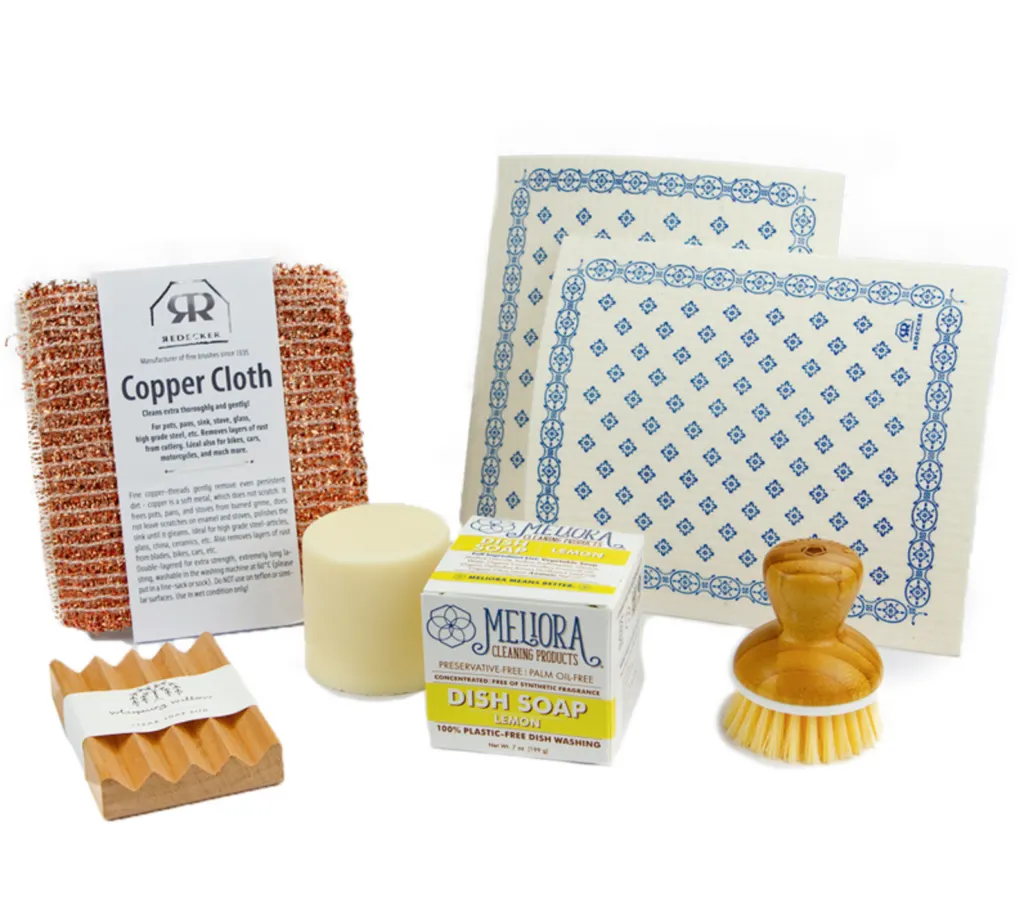
Use a water-saving washing technique
If you don’t have a dishwasher, you have an old machine that’s highly inefficient, or just prefer washing by hand – try using a technique that saves water.
This typically means scraping the food off the dishes before washing, washing quickly after use so the food doesn’t get stuck on the dishes, and turning off the faucet in between dishes so it’s only on when you’re actively scrubbing or rinsing dishes.
Wooden drying rack
Next time you buy a drying rack, opt for one made with 100% wood or bamboo – these can easily be found online or at your local thrift store. You could also just hand dry your dishes with a cotton towel if you want to put them back immediately after washing.
Having a sustainable kitchen is achievable. And if you take it step by step, you can have a zero waste kitchen in no time. But as always, remember that the most sustainable products are the ones you already have.
Sustainability doesn’t look a certain way or have a particular aesthetic – it’s all about using what you already have, and making smart choices about how and what you purchase in the future.
